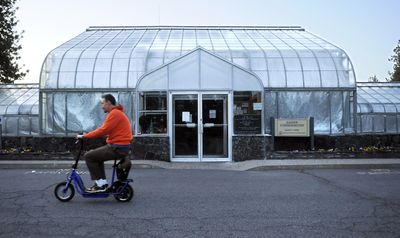Gaiser Conservatory holds much of Manito’s beauty

There’s a lot of foot traffic through the Gaiser Conservatory at Manito Park during its spectacular holiday lights display in December, and locals often bring out-of-town guests by to see what’s blooming there in the summer.
But the conservatory is a year-round attraction, so missing the early and late spring displays and the fall colors is missing more than half the show. And it’s been quite a show for many, many decades.
The first greenhouses at Manito were smaller, old structures that were moved in 1904 from nearby Liberty Park and located near 20th Avenue and Grand Boulevard. But 1912 marked the beginning of public horticulture in Spokane, said Merilee Dinneen, a member of the board of directors of the Friends of Manito and editor of the organization’s newsletter. That was the year when a conservatory and new greenhouses were constructed deeper in the park, at the current location adjacent to what are now the formal Duncan Gardens.
The Friends newsletters and the book “Manito Park: A Reflection of Spokane’s Past” by Suzanne Bamonte both give detailed information about the entire park and its history.
By the 1960s, the redwood rafters of the conservatory and greenhouses had rotted and the buildings needed constant repair. A new aluminum conservatory and adjacent greenhouses, designed by Lord and Burnham of New York City, were built at the existing location in 1974.
In 1988, the central dome of the conservatory was redesigned and enlarged, and the structure was named in memory of Dr. David Gaiser, the Spokane surgeon and civic leader who had been president of the Spokane Parks Board; he had died in 1985. The improved dome area includes a waterfall, fish pond and small bridge, and it is filled with tropical plants. About six years ago, an energy curtain was added, which has cut utility cost by 70 percent, according to Manito gardener Stephanie O’Byrne.
The conservatory is about 3,000 square feet and the greenhouses are about 10,000 square feet.
Now that it’s spring in Spokane, when most everyone has gleefully put away the snow shovels and grabbed a garden hoe, the Gaiser Conservatory is a visible inspiration for everything green and growing. There are many permanent residents within it – such as a succulent garden and many cacti with such great common names as pencil plant, Mexican snowball and cub’s paw.
But changing displays are the hallmark of the conservatory. In the early spring, the gardeners bring in from the greenhouses many spring bulbs. Later in the spring, Easter lilies are featured. The summer displays include begonias, impatiens and fuchsias. And in the fall, there are mums and cyclamen. It’s a feast of flora for all seasons. And then there’s the winter show.
In addition to the nearly 8,000 plants produced annually for the conservatory, the Manito greenhouse staff grows the 60,000 annuals used each spring for Manito, Riverfront Park, neighborhood parks and municipal golf courses.
Much of the work at the park is aided by the Friends of Manito, a group of concerned individuals who raise funds and volunteer to help maintain and improve the park they love. Dinneen said that from 1990 through January 2008, they provided $529,655 for projects such as sprinkler systems for the upper portion of the park ($50,000), Japanese Garden bridge replacement ($15,000) and a gazebo, pergola and informational kiosks ($80,000).
Despite all the spring and summer beauty of the park and the 1,800 people who signed the guest register at Gaiser Conservatory in June 2008 (from as far away as Australia, Brazil and Norway), it’s the month of December that draws the largest crowd to the conservatory.
That’s when a host of poinsettias are featured along with tens of thousands of lights strung up throughout the building, making for a fantastic display (especially in the evening), which was enjoyed by 6,500 people this past holiday season. It takes six weeks to prepare for the event.
O’Byrne said it’s a magical time at the conservatory, with the lush color and greenery contrasting with the cold and blustery winter outside. She recalls that last December, on the first day of what would turn out to be the beginning of a record snowfall in Spokane, the crowds had thinned toward the end of evening due to the worsening weather. But there was a young couple remaining.
“There, amid the twinkling lights and the foliage, they had the place almost to themselves.” O’Byrne said. “On the bridge there in the dome, with the snow falling outside, he dropped to one knee and proposed to her. It was the sweetest thing.”